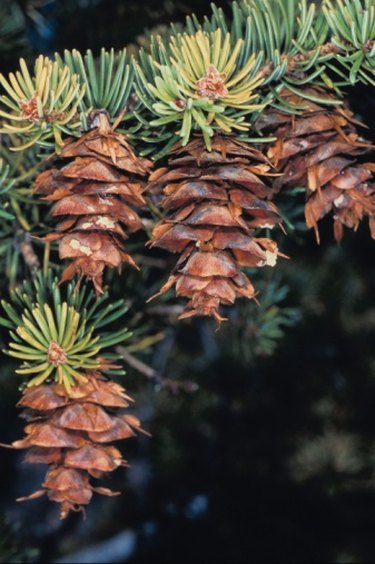
Also known as a red fir, Oregon pine, Douglas spruce and piño Oregon, the Douglas fir tree can grow to extraordinary heights in the wild. But it also makes a manageable landscape specimen. A part of American lore, the tree is widely used in the lumber industry and as an important Christmas symbol.
Growth Rate
Video of the Day
The Douglas fir (Pseudotsuga menisci) is an ornamental tree that is also widely utilized as a Christmas tree. It claims a medium rate of growth; a medium growth rate, according to the Arbor Day Foundation, signifies a tree that grows between 13 and 24 inches in height annually. An evergreen, this specimen possesses a straight trunk and grows into a pyramidal shape. It claims needles that are a mixture of blue and green or, occasionally, a combination of yellow and green.
Video of the Day
Size
The Douglas fir tops out at a height of between 40 and 70 feet with a spread of between 12 and 20 feet. The fruit of the tree is a light, brown cone that grows to a length of between 3 and 4 inches, with blooming occurring in April or May. The tree reaches it prime growth potential in U.S. Department of Agriculture Plant Hardiness Zones 4 through 6, an area that includes the cooler sections of the United States.
Environment
The Douglas fir appreciates full sunshine with a mixture of partial shade and grows best in deep, moist, well-drained soils with a pH between 5.0 and 6.0. It will not thrive or reach its full growth potential in poorly drained or highly compacted soils. The U.S. Forest Service indicates that although the tree is host to hundreds of fungi, few of those cause any considerable damage to the Douglas fir.
Varieties
Considered one of the most important timber trees in the world, two chief varieties of Douglas fir exist; one of them is Coast Douglas fir, which is native to British Columbia and stretches along the Pacific coast to central California and western Nevada. The second variety is the Rocky Mountain Douglas fir, native to the mountains of the Pacific Northwest and the Rocky Mountains from British Columbia to Mexico. The coastal variety is faster growing and can reach more than 300 feet tall.